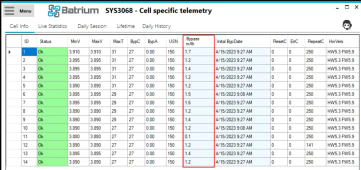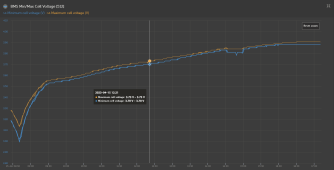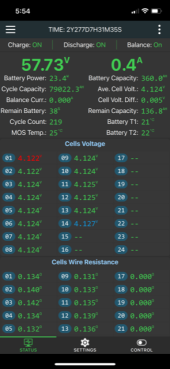Whelp... Time for another discharge test. Weather looked like it was going to cooperate and temps were more mild. With the adoption of Starlink, my DC loads are higher, and I don't have a protection scheme in place, so I only went down to 11% SoC rather than cut-off. I would have lost my internet connection and been unable to turn the MPPT back on.
Here's the whole discharge:
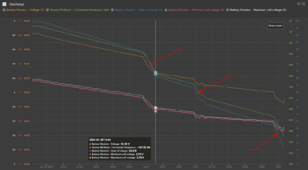
Took about 44 hours with the normal ~275W "background" loads and me remotely engaging a 1500W heater and a 12V charger. The usage of high drain items are indicated by the red arrows.
Here's the start:

and the end:
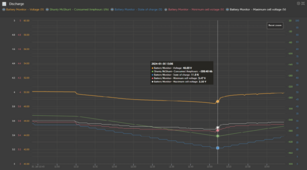
Start voltage: 4.16-4.18 (almost 100%)
End voltage: 3.47-3.50 (about 15-20% SoC)
Start SoC: 100% (VRM shows 99%, but BMS was reporting 100.0%)
End SoC: 11%
Ah consumed: 399.40Ah
Total cap calculated based on SoC:
399.40Ah/.89 = 449Ah, which is consistent with the programmed 450Ah.
I likely have 5-10% more total capacity BEYOND that, based on cell voltage, so again, I'm pretty happy. The low temp charge protection scheme is working, and there's been no measurable capacity loss since installation in 7/2022. Worth noting that these cells are from vehicles that are 7-11 years old, so calendar aging and cycle wear are both evident. New, the cells would yield 26.6kWh. This test yielded about 24.6kWh - about 92.5% SoH.
Cell delta was pretty constant throughout: .02-.04V
Of course, since it's working so well, and it meets our needs, there's no urgency to deploy the second battery of comparable capacity...

Lazy bastid...



